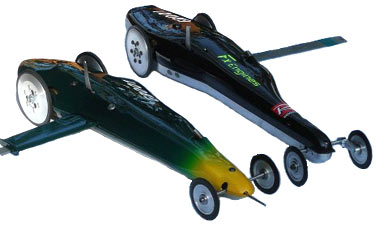

|
Home Updates Hydros Cars Engines Contacts Links Contact On The Wire |
"DJR 3" (Class E3 tether car)
The latest 3,5cc car built by David Giles for the 2006 competition season
The car has been designed to provide the minimum cross–sectional and projected area whilst covering all the relevant components, hence the ‘camel with broken back’ appearance!
|
|
The car soon after completion at the end of May 2006. The upper body is a CFRP moulding using 2 layers of 0,25mm thick carbon cloth and ‘West System’ epoxy resin cured at room temperature. The lower pan is machined from a billet of 19mm thick E30 Al alloy plate. Note that front axle fairings have yet to be fitted. It first took to the track at the European Championships in Poland, where it immediately earned the nickname of ‘old elephant ears’ due to the front suspension arrangement! |
|
Side elevation showing how pan profile follows the shape of the components to give minimum projected area. Front axle fairings are from litho plate filled with epoxy resin & micro balloons. They have an inverted aerofoil section and do not rotate with the front axle. Suspension damper is a ‘Kyosho’ VZ075 unit. |
|
|
|
|
View showing tuned length pipe, fuel tank & shutoff and on-board battery arrangement. Pipe is stainless steel, CNC machined by Eduard Stelling in Lithuania. Exhaust outlet and stinger bends are home constructed from brass. Feed problems have limited the performance to date; a new tank will be part of the preparation for the 2007 season. Engine is built around a ‘JP Racing’ FX21 crankcase (a "badge engineered" NovaRossi) using a mix of Nova and JP parts with modified porting and my own venturi & fuel feed system. |
|
|
These 2 views, from above and below, clearly show the amount of ‘sculpting’ to achieve a minimum sized car that complies with the rather prescriptive rules for this class. |
||
©copyright David Giles February 2007
Class E3 tether car "DJR 3" sets new UK record at the
‘Heidering’
near Hannover, Germany

For the UK based tether car enthusiast wishing to enter competitions the closest tracks are in mainland Europe. This unfortunately limits opportunities to test and develop one’s cars, so things do tend to progress rather slowly. Sometimes, with persistence and careful pre-race preparation a good result is achieved. This was the case at the "Modellautorennen Hannover" on 06 June 2010.
In 2006 I began the design and construction of "DJR 3" which is the third car in my development series. It was completed in May of that year. It first took to the track at the European Championships in Poland. The car, although reliable, has never reached its true potential in spite of a fair amount of development work on the engine and pipe.
For the 2010 racing season modifications made to the car have been to check and adjust the longitudinal balance by adding 55g to the nose in the form of car wheel weights and to increase the rear (drive) tyre diameter by a nominal 1.5mm. Tyre diameter is a variable in the gearing of the car and is an educated guess based on condition of track surface, relative humidity, exhaust timing and one’s own reading of weather conditions on the day.
We try and attend 3 race meetings a year and make them into mini breaks, thus our trip to Hanover began on Wednesday 02 June with a drive to Kent to see relatives and a night stop close to the Channel Tunnel terminal. The following day we drove to a favourite hotel in the village of Ahlen - Vorhelm for a very comfortable overnight stop. On Friday 04 June we made the comparatively short (100 miles) drive to the track which is to the east of Hannover, quite close to the airport. Total distance from home: 614 miles! The track is set in a large area of meadow and is surrounded by mature silver birch trees planted when the track was built just over 50 years ago. After checking into our nearby hotel, and greeting lots of friends, we prepared to test run the cars. The re-balancing of the car "DJR 3" made a considerable difference to its performance, so I had high hopes for the competition. My second car, fourth in the series and named "Papagai", is still a little temperamental but potentially should be the faster. It ran very well but needs more work on the piston/cylinder fit and tank setup.
Competitions are normally run over two days and depending on number of entries three runs are possible in each class. On the first run with "DJR 3" it was clear that the car was running very well.
|
|
As can be seen in the printout from the electronic timing gear, the car was accelerating well and the pipe comfortably in resonance, so I pressed the button to start the timing on lap 29. The 8 timed laps are averaged and give the final speed for the half kilometre. As the eagle eyed will notice, if I had called it in 1 or 2 laps later, I would have had an even better result. However, 241.285kph was enough to break the existing UK record, held since 2004 by June Heath with one of my earlier cars ("DJR 2"). Note that the car covered the race distance in 7.46 seconds with the engine peaking at 39,500 rpm. |
This was a very pleasing personal success, as I have finally broken the 240kph barrier. It has taken a lot of time and effort. The record for the class is currently held by Mart Sepp of Estonia at 258.129kph, so I still have some way to go, but my next goal is to break 250kph, the current benchmark speed for the class.
© David Giles June 2010
Thanks to David for producing this material for OTW.